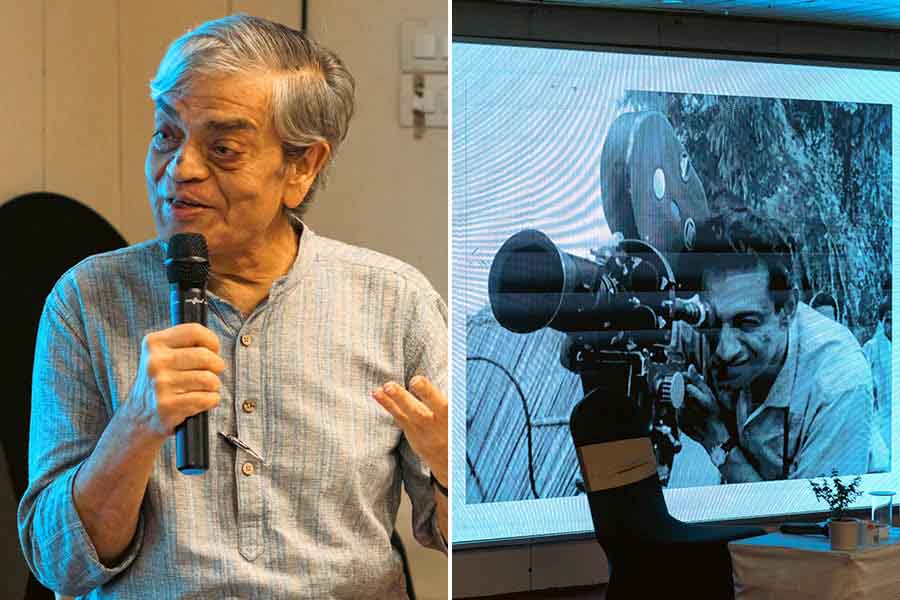Born to one of the all-time greats of cinema, Sandip Ray’s life has revolved around cinematography — from watching his father create magic to telling magical stories himself, the 70-year-old director was at Techno India to speak about his experience in filmmaking and carrying forward the legacy of Satyajit Ray.
Unwind-Boi Kotha Kow is a concept similar to The Human Library which aims to turn the lives of people into an open book to help those who may seek inspiration get an in-depth understanding of the various experiences the person may carry. The idea being to gain knowledge and take important lessons from the life of the speaker.
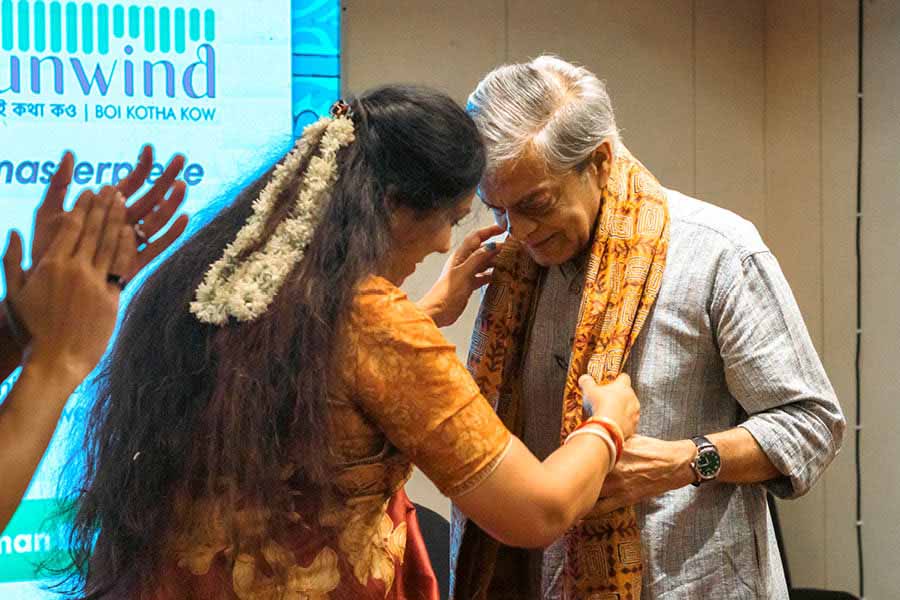
Techno India Group co-chairperson Manoshi Roychowdhury welcomes Sandip Ray to the event.
The brainchild of Manoshi Roychowdhury, the co-chairperson of Techno India Group, Unwind aims to bring the lives of prominent individuals and share their experience among the students of Techno India in an effort to increase their holistic development and world view.
Techno India welcomed filmmaker Sandip Ray on its Salt Lake Sector V main campus on June 28 for a chat with Roychowdhury on how he perceived his father’s films as well as the experience of making his own. Splitting the conversation into two halves, the first was about Satyajit Ray and the second about Sandip Ray before the floor was opened to those curious to pose their questions to the director.
About Satyajit Ray
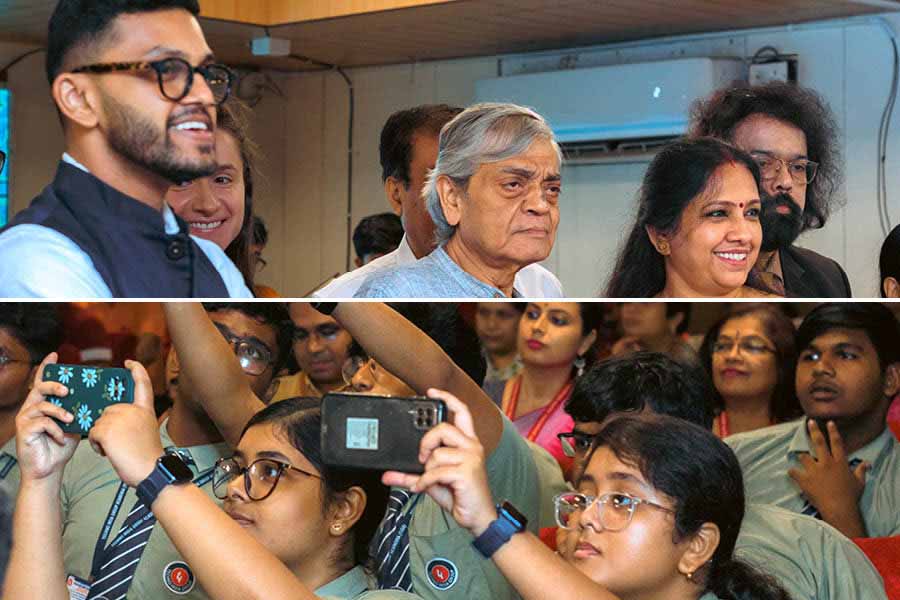
(Top) Sandip Ray flanked by Meghdut Roychowdhury and Manoshi Roychowdhury of Techno India Group and (above) members of the audience take pictures.
To start off the discussion, Roychowdhury asked Ray Junior what it was like growing up as Satyajit Ray’s son and if he had any memories of his childhood when he figured out who his father was. “I’ve grown up in this world. In my earlier days, I would go with my father for shoots but it felt like a picnic because I was too young to comprehend what was happening. There were known faces all around me and I got an essence that something was happening but it took me a while to realise that this was the shoot for a feature film and they were all working. ”
It was later that he learnt exactly what was happening and he realised that his father would ensure that the outdoor shoots matched with Sandip’s school holiday schedule. “I remember Baba always wanted us to be with him on set, especially when it was for outdoor scenes. He would always schedule the shoot to coincide with my holidays, so I was always with him and those are the memories I cherish the most because not only could I see the effort he and the cast were putting in to ensuring that the scenes were perfect but it also taught me a great deal which I still carry with my to this day,” Sandip said.
One of the things about shooting that intrigued a young Sandip Ray the most was a contraption that would look like a train track on which the camera would move. “I remember the shooting of the cocktail scene in Parash Pathar and how this camera was moving on a train track in this huge contraption. Other than that what I very fondly recall is sitting and watching Baba edit his films. That was something that always piqued my interest — how each scene was being brought together with this beautiful flow being maintained,” said Sandip, who considers himself a student of editing more than anything else.
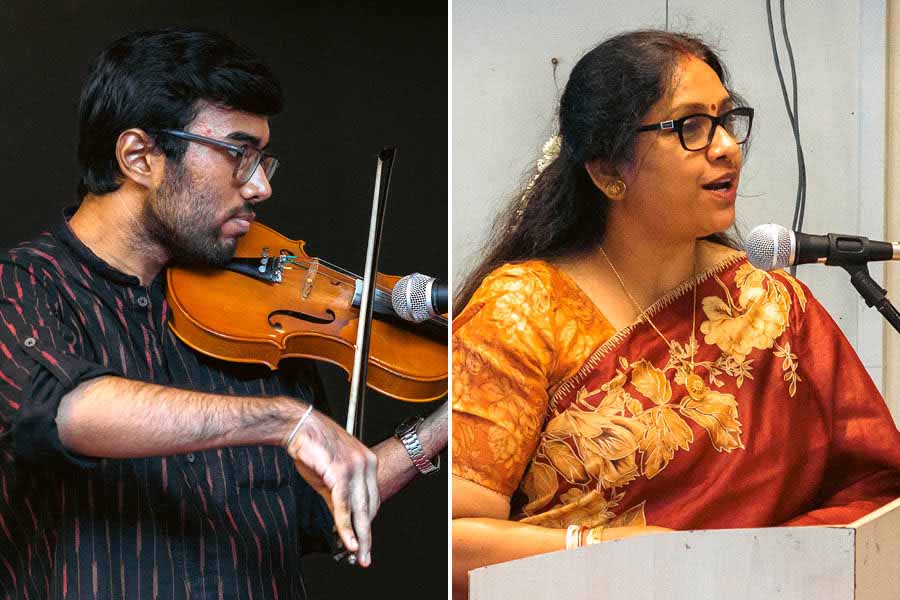
A student strummed together some of the most iconic tunes from Satyajit Ray's films before the address and discussions began.
Asked about his favourite films of Satyajit Ray and whether he would like to turn one of his father’s short stories into a film, Sandip said: “I have watched most of Baba’s films being created from very close, so it’s very hard for me to say that I have a favourite. I have different emotional connects with each film but I have worked with his short stories before in Jekhane Bhooter Bhoye and Chaar and in the coming days, too, I will be working with a lot of short stories because I have a special interest in them.”
Prompted by Roychowdhury on whether he intended to remake any of his father’s films, Sandip was quick to say: “I don’t have that courage. When you remake a film, you believe that you can do it better but how do I perfect an already perfect movie? I don’t think it’s worth making something if there is no scope for improvement.”
On his own experiences
Embracing what he thought was the best way has been Sandip’s way of tackling the pressure of Satyajit Ray’s son.
“It was obviously a pressure being his son but then I had to embrace it because if you fear that you have to live up to be greater than your father and are weighed down by the expectations and how to deal with failure, you might as well sit at home and not do anything. I had to embrace it all and do things my way,” Sandip said.
Recalling an anecdote about the shooting of his directorial debut Phatik Chand, Sandip said: “I remember during the shooting of Phatik Chand, I did not allow my father on the set. One day he came and said ‘you won’t even give me a cup of tea’ so I gave him tea, we talked and I shooed him away because I needed to do this on my own. Once the film was released, I was very happy because everyone was saying this is completely done by Satyajit Ray when I knew for a fact I didn’t let him get involved, so that kind of reaction to my movie told me I was on the right track and had done a good job.”
But when Satyajit Ray’s failing health made it impossible for him to work,
Sandip Ray made sure that he was on the sets of his films. “After his heart attack, Baba was unable to work and more than anything he missed the atmosphere of the studio, so I would call him on set just so that he could enjoy the feeling of being in the studio which he thoroughly enjoyed.”
One of the most valuable lessons Sandip learnt from his father was to cut films short and not make them too lengthy “Baba said that the film cannot be too long or the audience will get jittery. I showed him my first edit of Phatik Chand which was about 2 hours 10 minutes long and he said ‘my films are all 1 hour 45 minutes long so the audience is captivated to ensure that remains the same with your films you have to cut it down’. One more thing he told me was that it looked like each scene was shot like it’s my last film and each scene has to have a massive impact. His advice was to keep the major details in place but not make each scene like a huge moment or it could hurt the film,” said Sandip Ray.
About Feluda films
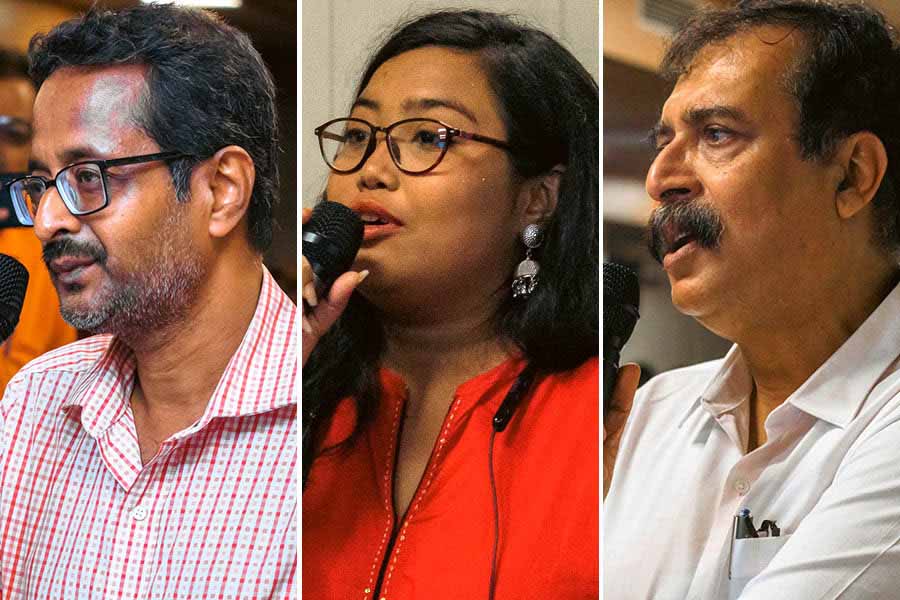
Members of the audience pose questions to Sandip Ray.
While he does have a soft spot for Satyajit Ray’s short stories, Feluda is one of the most important characters for Sandip. “I have shot so many films, several with Feluda and a whole lot of individual films but what I have noticed is that while shooting other films feels like a piece of cake, all sorts of problems occur with Feluda. From tight shooting schedules to several mishaps on set and everything else in between, Feluda films have been the most difficult to shoot and get the best out of. For whatever reason shooting a Feluda film is never smooth sailing,” said Sandip.
The question was brought up by a student who asked what is the most important element of a detective film. Breaking it down and taking the question with great importance, Sandip Ray said “There are several aspects to this. The two Feluda movies that Baba made were thrillers and not whodunits. Baba believed that thriller formats work better because what happens with whodunits is that in the end where the detective reveals everything there is a lot of hochpoch. He believed that people would not watch such films a second time and they would lose value. Chiriyakhana was different because it was supposed to be done by a different director. I had to do Feluda films for TV in a whodunit format because it was meant for one time viewing.”
“When I did Bombaiyer Bombete I remembered Baba and went back to the thriller format. But I was told off by a lot of people for not going back to whodunit format because the audience had changed and they were more receptive to it so based on that feedback I returned to the whodunit format with all the other Feluda movies. I would say it is up to the individual which format they see the film being a bigger success.”
With the talk of Artificial Intelligence everywhere, Sandip too was asked about the growing use of AI in films and how he saw it. “I have seen the rise of AI quite a bit, I wouldn’t like to use it in my films. As far as I see it AI is doing a pretty realistic job with voices but I think audio and video are two very different mediums to tackle. The biggest thing with AI is that the human touch will be lost. AI at the end cannot replace humans and the human touch and emotions so to use it in films would be equivalent to losing the human touch which is often the base of great storytelling,” said Sandip.
